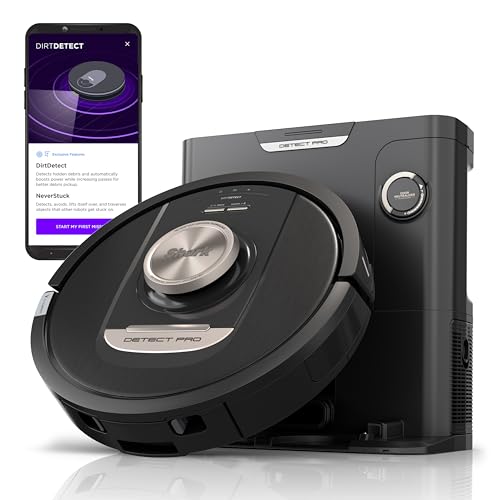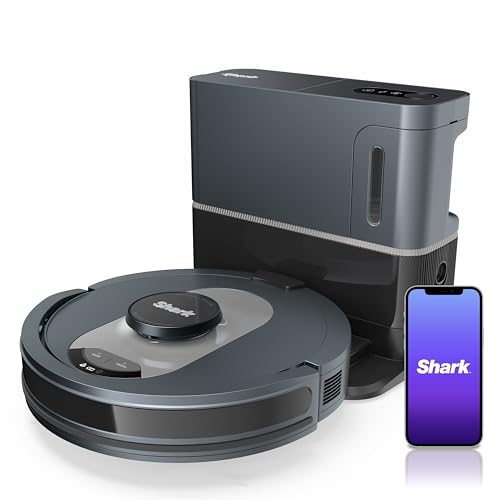Guide To Bagless Programmed Cleaners: The Intermediate Guide In Bagles…
페이지 정보
작성자 Kandy 댓글 0건 조회 43회 작성일 24-09-06 01:02본문
Bagless Programmed Cleaners
Bagless programed cleaners are designed so that they can gather dust and other particles into a clear chamber that is easily emptyable. These machines do have some disadvantages that users must be aware of.
When you empty the chamber, it can cause allergens to escape into the air. This could be a huge issue if you suffer from allergy issues.
Cost
Bags for vacuum cleaners cost roughly five dollars per bag and need to be replaced often which can be costly when you have a big home. bagless automated sweepers cleaners, on other hand, do not require bags and collect dirt and debris in a tank that is built into the machine, which means you won't need to spend more on replacement parts. However, you will need to clean or replace the filter regularly to ensure that it is working properly.
Convenience
Bagless cleaners are more effective in cleaning. bagless automatic vacuums cleaners can eliminate the frustration caused by trying to put a bag back together after you have empty it. In addition, they help you save time by making it easier to move through the chores of vacuuming. You'll also never have to waste money by buying bags that you need to throw away when they're full.
bagless automated sweepers cleaners have a longer life time and are more eco friendly than their counterparts. They don't have to use 100 bags or more over their lives. This can be harmful to the planet. They also have dustbins that are regularly cleaned, which will prevent dust and other allergens from resurfacing in your home.
When it comes to choosing which bagless robotic sweepers cleaner to select, make sure you choose one that has a HEPA filter. This filter acts as a powerful shield that allows only large particles to pass, keeping dust particles smaller in the air. These filters are recommended for people with asthma or allergies.
The cyclonic technology utilized in bagless cleaners is highly effective for cleaning the air in your home. It works by separating the fine and heavy dust from the rest of the air by the cyclones' rotation. This prevents the dust from recirculating throughout your home and helps keep it at a healthy level. Cleaners that are bagless and cyclonic also require less maintenance since they don't need to be replaced as frequently as those with a traditional bag. However, they still need to be cleaned regularly (see the manual for an exact schedule).
Environmental impact
Bagless vacuum cleaners are a great tool for keeping your home tidy. Their advanced filtering systems can remove dust and allergens, improving indoor air quality and ensuring compliance with OSHA regulations. The vacuum cleaners also decrease the use of disposable bags, which decreases maintenance costs and environmental impact. There are a variety of vacuum cleaners, each one with its own pros and pros and. All of them have HEPA filters that remove tiny particles. This feature is ideal for allergy sufferers and those who are sensitive to pollution.
 Recent trends have seen vacuum cleaners that have higher power ratings, which increase their energy consumption and environmental impact. The implementation of the Eco-Design and Waste Electrical and Electronic Equipment (WEEE) directives, as well as the decarbonisation of the electricity mix in Europe could have an impact on the environmental performance of these devices. This paper analyzes their environmental impacts throughout their entire life-cycle, taking both indirect and direct impacts into consideration.
Recent trends have seen vacuum cleaners that have higher power ratings, which increase their energy consumption and environmental impact. The implementation of the Eco-Design and Waste Electrical and Electronic Equipment (WEEE) directives, as well as the decarbonisation of the electricity mix in Europe could have an impact on the environmental performance of these devices. This paper analyzes their environmental impacts throughout their entire life-cycle, taking both indirect and direct impacts into consideration.
The main impact is during the usage phase, where they consume lots of energy. This is primarily because of the huge energy consumption of vacuum cleaners over their lifetime, as well as the dominant role that fossil fuels play in the European electricity mix. Raw materials and the end-of-life stages are important, but are not as important as the use stage.
 The results indicate that combining the ecodesign regulation with the decarbonisation of electricity would result in a significant reduction in the overall impact of vacuum cleaners. This will happen by 2020. The WEEE directive alone is expected to have a small impact, but it will be offset by an increase in the quantity of vacuum cleaners. This is due to the fact that the improvement in energy efficiency of these appliances depends on other policies that reduce emissions such as those relating to nuclear and renewable energy.
The results indicate that combining the ecodesign regulation with the decarbonisation of electricity would result in a significant reduction in the overall impact of vacuum cleaners. This will happen by 2020. The WEEE directive alone is expected to have a small impact, but it will be offset by an increase in the quantity of vacuum cleaners. This is due to the fact that the improvement in energy efficiency of these appliances depends on other policies that reduce emissions such as those relating to nuclear and renewable energy.
Bagless programed cleaners are designed so that they can gather dust and other particles into a clear chamber that is easily emptyable. These machines do have some disadvantages that users must be aware of.
When you empty the chamber, it can cause allergens to escape into the air. This could be a huge issue if you suffer from allergy issues.
Cost
Bags for vacuum cleaners cost roughly five dollars per bag and need to be replaced often which can be costly when you have a big home. bagless automated sweepers cleaners, on other hand, do not require bags and collect dirt and debris in a tank that is built into the machine, which means you won't need to spend more on replacement parts. However, you will need to clean or replace the filter regularly to ensure that it is working properly.
Convenience
Bagless cleaners are more effective in cleaning. bagless automatic vacuums cleaners can eliminate the frustration caused by trying to put a bag back together after you have empty it. In addition, they help you save time by making it easier to move through the chores of vacuuming. You'll also never have to waste money by buying bags that you need to throw away when they're full.
bagless automated sweepers cleaners have a longer life time and are more eco friendly than their counterparts. They don't have to use 100 bags or more over their lives. This can be harmful to the planet. They also have dustbins that are regularly cleaned, which will prevent dust and other allergens from resurfacing in your home.
When it comes to choosing which bagless robotic sweepers cleaner to select, make sure you choose one that has a HEPA filter. This filter acts as a powerful shield that allows only large particles to pass, keeping dust particles smaller in the air. These filters are recommended for people with asthma or allergies.
The cyclonic technology utilized in bagless cleaners is highly effective for cleaning the air in your home. It works by separating the fine and heavy dust from the rest of the air by the cyclones' rotation. This prevents the dust from recirculating throughout your home and helps keep it at a healthy level. Cleaners that are bagless and cyclonic also require less maintenance since they don't need to be replaced as frequently as those with a traditional bag. However, they still need to be cleaned regularly (see the manual for an exact schedule).
Environmental impact
Bagless vacuum cleaners are a great tool for keeping your home tidy. Their advanced filtering systems can remove dust and allergens, improving indoor air quality and ensuring compliance with OSHA regulations. The vacuum cleaners also decrease the use of disposable bags, which decreases maintenance costs and environmental impact. There are a variety of vacuum cleaners, each one with its own pros and pros and. All of them have HEPA filters that remove tiny particles. This feature is ideal for allergy sufferers and those who are sensitive to pollution.
 Recent trends have seen vacuum cleaners that have higher power ratings, which increase their energy consumption and environmental impact. The implementation of the Eco-Design and Waste Electrical and Electronic Equipment (WEEE) directives, as well as the decarbonisation of the electricity mix in Europe could have an impact on the environmental performance of these devices. This paper analyzes their environmental impacts throughout their entire life-cycle, taking both indirect and direct impacts into consideration.
Recent trends have seen vacuum cleaners that have higher power ratings, which increase their energy consumption and environmental impact. The implementation of the Eco-Design and Waste Electrical and Electronic Equipment (WEEE) directives, as well as the decarbonisation of the electricity mix in Europe could have an impact on the environmental performance of these devices. This paper analyzes their environmental impacts throughout their entire life-cycle, taking both indirect and direct impacts into consideration.The main impact is during the usage phase, where they consume lots of energy. This is primarily because of the huge energy consumption of vacuum cleaners over their lifetime, as well as the dominant role that fossil fuels play in the European electricity mix. Raw materials and the end-of-life stages are important, but are not as important as the use stage.
 The results indicate that combining the ecodesign regulation with the decarbonisation of electricity would result in a significant reduction in the overall impact of vacuum cleaners. This will happen by 2020. The WEEE directive alone is expected to have a small impact, but it will be offset by an increase in the quantity of vacuum cleaners. This is due to the fact that the improvement in energy efficiency of these appliances depends on other policies that reduce emissions such as those relating to nuclear and renewable energy.
The results indicate that combining the ecodesign regulation with the decarbonisation of electricity would result in a significant reduction in the overall impact of vacuum cleaners. This will happen by 2020. The WEEE directive alone is expected to have a small impact, but it will be offset by an increase in the quantity of vacuum cleaners. This is due to the fact that the improvement in energy efficiency of these appliances depends on other policies that reduce emissions such as those relating to nuclear and renewable energy.댓글목록
등록된 댓글이 없습니다.